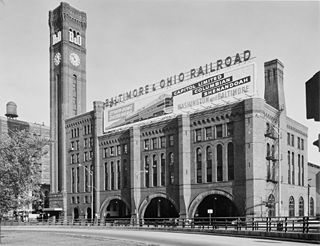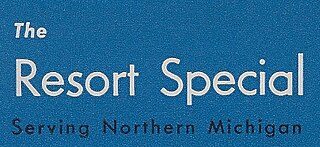The Pere Marquette Railway operated in the Great Lakes region of the United States and southern parts of Ontario in Canada. It had trackage in the states of Michigan, Ohio, Indiana, and the Canadian province of Ontario. Its primary connections included Buffalo; Toledo; and Chicago. The company was named after Jacques Marquette, a French Jesuit missionary who founded Michigan's first European settlement, Sault Ste Marie.

The Grand Trunk Western Railroad Company was an American subsidiary of the Grand Trunk Railway, later of the Canadian National Railway operating in Michigan, Illinois, Indiana, and Ohio. Since a corporate restructuring in 1971, the railroad has been under CN's subsidiary holding company, the Grand Trunk Corporation. Grand Trunk Western's routes are part of CN's Michigan Division. Its primary mainline between Chicago and Port Huron, Michigan serves as a connection between railroad interchanges in Chicago and rail lines in eastern Canada and the Northeastern United States. The railroad's extensive trackage in Detroit and across southern Michigan has made it an essential link for the automotive industry as a hauler of parts and automobiles from manufacturing plants.

Michigan Services are three Amtrak passenger rail routes connecting Chicago, Illinois with the Michigan cities of Grand Rapids, Port Huron, and Detroit, and stations en route. The group falls under the Amtrak Midwest brand and is a component of the Midwest Regional Rail Initiative.

A railroad car float or rail barge is a specialised form of lighter with railway tracks mounted on its deck used to move rolling stock across water obstacles, or to locations they could not otherwise go. An unpowered barge, it is towed by a tugboat or pushed by a towboat.

Central Station was an intercity passenger terminal in downtown Chicago, Illinois, at the southern end of Grant Park near Roosevelt Road and Michigan Avenue. Owned by the Illinois Central Railroad, it also served other companies via trackage rights. It opened in 1893, replacing Great Central Station, and closed in 1972 when Amtrak rerouted services to Union Station. The station building was demolished in 1974. It is now the site of a redevelopment called Central Station, Chicago.

Grand Central Station was a passenger railroad terminal in downtown Chicago, Illinois, from 1890 to 1969. It was located at 201 West Harrison Street on a block bounded by Harrison, Wells and Polk Streets and the Chicago River in the southwestern portion of the Chicago Loop. Grand Central Station was designed by architect Solon Spencer Beman for the Wisconsin Central Railroad (WC), and was completed by the Chicago and Northern Pacific Railroad.
The Porter Subdivision is a railroad line owned by CSX Transportation in the Chicago, Illinois, area. Formerly a part of the main line of the Michigan Central Railroad, it now connects CSX's former Baltimore and Ohio Railroad line and the Chicago Fort Wayne and Eastern Railroad from the east with the Indiana Harbor Belt Railroad towards Blue Island, Illinois.

Martin Luther King Jr. Plaza is the main passenger rail and intercity bus station of Toledo, Ohio.

The Union Depot is a former train station, located at 637 E. Michigan Avenue in Lansing, Michigan. It was listed on the National Register of Historic Places in 1995. Despite the union name, Grand Trunk Western trains stopped at a different station in Lansing 1.5 miles away.
The Steam Railroading Institute is located at 405 South Washington Street, Owosso, Michigan. It was founded in 1969 as the Michigan State University (MSU) Railroad Club. It became the Michigan State Trust for Railway Preservation, and later adopted its present name.
The Baltimore and Ohio and Chicago Railroad (B&O&C) was a subsidiary of the Baltimore and Ohio Railroad (B&O) that owned the line from Willard, Ohio to Chicago, Illinois.
The Night Express was an American named train of the Baltimore and Ohio Railroad (B&O) on its route between Detroit, Michigan, and Louisville, Kentucky, with major station stops in Toledo, Ohio, and Cincinnati. The service was numbered Train 57 southbound and Train 58 northbound. The numbers 57/58 operated on the Detroit - Cincinnati line as early as 1921. The service was provided in conjunction with the Pere Marquette Railroad from Detroit to Toledo and with the Louisville and Nashville from Cincinnati to Louisville with connections to New Orleans.

The Fort Street Union Depot was a passenger train station located at the southwest corner of West Fort Street and Third Street in downtown Detroit, Michigan. It served the city from 1893 to 1971, then demolished in 1974. Today, the downtown campus of Wayne County Community College occupies the site.

The Chesapeake & Ohio Railway Station is a railway depot located in Pioneer Park on West Lake Street in Petoskey, Michigan. It was placed on the National Register of Historic Places in 1970. The building now houses the Little Traverse Historical Museum.

Grands Rapids Union Station was a union station in Grand Rapids, Michigan. A Georgian Revival building of two stories, it was built in 1900 and was closed in 1958 and demolished over 1958 and 1959 to make space for a highway. Its address was 61 Ionia Avenue. It was a hub serving a few railroads going to different points in Michigan and other points in the Midwest.

The Resort Special was a seasonal night train from Chicago, renowned for serving resort towns such as Traverse City, Charlevoix, Petoskey on the northwestern part of Michigan’s lower peninsula. Begun by the Pere Marquette Railway, it was a rare instance of a named Pere Marquette train continuing after the Chesapeake & Ohio absorbed the Pere Marquette Railway in 1947. In 1960s, the C&O shifted the Resort Special name to a White Sulphur Springs, West Virginia to New York City route.












